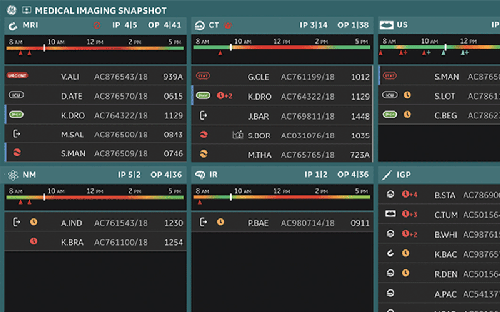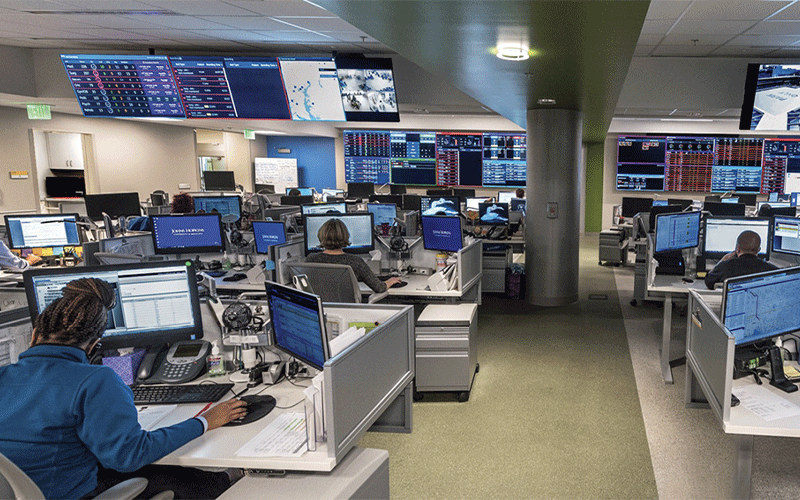NASA-Style Command Centers Improve Workflow Efficiency in Medical Imaging
Radiology benefits from data-driven centers


In 2017, Toronto’s Humber River Hospital faced a set of daunting challenges in terms of increase in patient volume and corporate flow efficiency in the Emergency Department.
Patients were spending too much time in the ED, creating a bottleneck in transitioning them to inpatient care. In addition, there was little, or no awareness of the hospital’s patient capacity status or real-time awareness of when patient care activities were delayed or even missed. Adding additional pressure to the situation, the hospital had a projected shortfall of as many as 40 to 50 hospital beds by 2021, further impeding the efficiency process.
The solution was to establish a Command Centre; a highly advanced, data driven ‘mission control’ center designed to process real-time data from multiple source systems, including radiology. By 2018 the hospital had launched an imaging application as part of the Command Centre – the medical imaging tile. The tile, coupled with a medical imaging flow technologist located in the command center, further enabled the active management of imaging utilization by prioritizing scans, and identifying the many issues that disrupt both inpatient and outpatient flow.
“The beauty of the command center is not only the data and the technology, but that it is located in a centralized place where everything happens in a synchronized fashion,” said Susan Tory, MD, command center medical director and general internist.
The center is inspired by the concept of NASA’s mission control center. Centrally located in a 4,500 square-foot space, the Humber River Hospital Command Centre houses four offices, two meeting rooms, 20 workstations and 33 LCD screens. The center has a staff of 20, including a medical imaging flow technologist.

Ellen Francesconi (left), medical imaging technologist, with Paula McFee-Grant, clinical expediter and patient flow manager at the command center, at Humber River Hospital. — Images courtesy of Humber River Hospital
One of the first hospitals to adopt such a NASA-style clinical command center was The Johns Hopkins Hospital in Baltimore, MD, which opened its Capacity Command Center in 2016. Designed and built with GE Healthcare Partners, the center relies on data, predictive analytics, and machine learning to better manage hospital capacity. In terms of radiology, the system helps align scheduling for patients who need one or more imaging exam and uses predictive analytics to prioritize patient treatment.
“I see the command center as the place to expedite patients, to get them in the right spot in the hospital at the right time, and to figure out any barrier that prevents them from being where they need to be, whether it’s getting them out the door to go home, or scheduling them for a test such as an imaging exam,” said Stacey Baldwin, president, Johns Hopkins Medical Imaging and radiology administrator.
“Some of those barriers are more easily tracked in terms of a dashboard, while some require bi-directional communication that can vary widely from patient to patient,” Baldwin said. “That is what I see as a challenge to really having radiology using the command center to help expedite testing.”
For example, the way the hospital’s electronic medical records (EMR) interact with the command center may not, in some cases, give technologists and clinical managers the ability to give feedback directly through the EMR and into the command center dashboard.
So, while the high-tech system greatly aids hospital efficiency in many areas, human involvement is still necessary.Imaging Tile Aids Efficiency
At the Humber River Hospital Command Centre, the human element is provided by Ellen Francesconi, the command center medical imaging technologist.
Humber River is one of the first hospitals in the world to install a medical imaging “tile” which displays the length of time a patient has been waiting for an imaging scan. The tile prioritizes the scan based on the urgency and location of the exam. Every imaging exam ordered appears on the imaging tile and every patient is flagged based on turnaround times, which are 48 hours for MRIs and 24 hours for CTs.
“Once an exam is ordered, it appears on the heat map and I can see where it has been scheduled,” Francesconi said. “If there is an issue, for example, where the patient has elevated creatinine, but cannot have a contrast injection because they are not on dialysis then the technologist can help communicate this barrier to the inpatient team to see if the patient’s condition can be optimized to allow the test to be carried out.”
That exam stays on the tile, and as time passes will start to display certain colors, turning orange as it approaches 18 hours.
“Once it hits 24 hours it appears red and a flag forms,” Francesconi said. “The next step is to figure out what is wrong. For that, I will talk to the clinical team, radiologist or nurses to solve the problem. I basically take care of the things technologists might have to spend hours or days doing on the phone, so they can scan or attend to their patients.”

Humber River is one of the first hospitals in the world to install a medical imaging “tile” which displays the length of time a patient has been waiting for an imaging scan. The tile prioritizes the scan based on the urgency and location of the exam. Every imaging exam ordered appears on the imaging tile and every patient is flagged based on turnaround times.
The impact of the command center and medical imaging tile is reflected in important imaging metrics. One example: The time it takes from a physician order to completion for a CT or an MR exam has been reduced by 48%.
This kind of improvement leads to increased patient satisfaction. “If you can get a patient in and get their test done on time, they are going to be happy,” Francesconi said. And according to Jane Casey, the command center director, patient, staff, and physician satisfaction has gone up at Humber, and the introduction of the medical imaging tile has contributed to patient satisfaction.
Humber River staff have been positively affected as well, Dr. Tory said.
“From a physician standpoint, having the technology to coordinate and organize the medical imaging requests and tests to get them done more rapidly, and having the medical imaging technologist in the command center in conjunction with the imaging tile has been incredibly beneficial to help move things forward,” Dr. Tory said. “If I have a concern, the medical imaging technologist is there as the point of contact so that I don’t have to phone the CT desk or try 10 different extensions to get a scan done more rapidly.”

One of the first hospitals to adopt a NASA-style clinical command center was the Johns Hopkins Hospital (above), which relies on data, predictive analytics, and machine learning to better manage hospital capacity. — Image courtesy of Johns Hopkins Medicine